Scientific excellence and technical creativity were the centrepieces at the annual induction ceremony and dinner of the Canadian Mining Hall of Fame in mid-January, with six inductees that were all most notable either for their own technical contributions or for their support for the technical advances of others.
The Hall of Fame welcomed mining engineers William Brissenden and Marsh Cooper, geologists Stuart Dadson, Richard Geren and James Harrison, and metallurgist John Thompson as its newest inductees. All were active during the post-war economic expansion — as much as any time a gilded age for Canadian mining.
In attendance at the dinner were four earlier Hall of Fame inductees: Maurice Brown, former editor of The Northern Miner; Charles Michener, a founder of consulting firm Derry Michener & Booth; Alfred Powis, former president of Noranda; and Harold Seigel, a pioneer in geophysical exploration.
Also recognized were two recently deceased inductees, Falconbridge Copper and Soquem executive Cme Carbonneau, and much-travelled minefinder Stephen Ogryzlo.
The inductees for 2001 all showed a taste for bold, even aggressive, technical development. Long-time Noranda and Patino engineer William Brissenden (born 1915) was inducted for his innovations in mining at the Gasp Copper and Brunswick mines, and for his championing of metallurgical advances throughout the Noranda organization. Presenting Brissenden’s citation, Alex Balogh, chairman of Falconbridge, pointed to “the remarkable personal sacrifices you made on our behalf,” adding that “there are many here tonight that are proud to have been part of your team.”
In his remarks, Brissenden dwelt on the satisfaction of having been part of Gasp Copper for its entire life. “I had the unique opportunity to be involved with [Gasp] from start to finish. . . . Even today, though the main ore zones have been depleted, a smelter remains.”
Former Falconbridge president Marsh Cooper (born 1912), inducted as a great builder of the Falconbridge organization, sugested that he “had been in the right place at the right time more often than most.”
Cooper also recalled one of his Falconbridge linecutting crews, made up of eventual National Hockey League players Max Bennett, Adie Lafrance, Murph Chamberlain and Hector (Toe) Blake. Chamberlain had arranged for a friend to work at Falconbridge, telling the company that the man played centre. The friend, who didn’t play hockey at all, worked through the summer but felt certain he would lose his job once practices began in September. The friend approached Chamberlain, who was sharpening an axe, to confess his fears; Chamberlain replied with an axe-handle blow that disabled the friend’s wrist, saying “now you’re good till Christmas.”
Toe Blake, who was watching the exchange, commented, “Murph, that was generous of you.”
Another Falconbridge great, geologist Stuart Dadson (1906-1968), was inducted for his contribution to the discoveries of the Giant gold mine in the Yellowknife camp and the Norbec and Millenbach base metal deposits near Noranda.
Working in the 1940s in the Yellowknife camp, Dadson performed a structural analysis of the area that led to the discovery of the Giant orebody, which became the largest gold mine in the district.
In the late 1950s, Dadson’s recommendation for deep exploration on the Lac Dufault property led to two discoveries: in 1961, a deep drill hole revealed the Norbec orebody, and in 1966 additional deep drilling found the Millenbach deposit.
Consulting geologist Stanley Charteris, presenting the citation to Dadson’s son Peter, paid tribute to Dadson as “an outstanding geologist and a gentleman in every sense of the word.”
Accepting the citation, Peter Dadson replied that his father “got me started in this business many years ago, and I’m still in it.”
Richard Geren (born 1917), who discovered and developed the gigantic iron-ore deposits of the Knob Lake region for Labrador Mining and Exploration, was told that his legacy would see Iron Ore Co. of Canada as the second-largest producer of iron-ore pellets in the world. IOC’s president, Richard Knight, noted the immense strategic importance of the Labrador development for the steel industry of the 1950s, saying “few people today recognize the significance of the Knob Lake project of that time.”
Geren, who is also co-author of Cain’s Legacy, a book on the history of the Labrador North Shore development, said his success depended greatly on his co-workers. “We had the best quality workmen you could find anywhere. . . . I was always fortunate in having an excellent group of workers around me.” They needed to be excellent, too, Geren said: “It was really a forbidding country; you had to have a special kind of guy to make a go of it.”
Contributions to science, and so to the mineral industry, earned James Harrison (1915-1990) a place in the Hall. Harrison, former director-general of the Geological Survey of Canada, presided over a period when the Survey rose to dominant heights among the world’s earth-science agencies, but always saw its principal mission as service to prospectors and the resource industries.
James Gill, president of Aur Resources, told Harrison’s stepson, Norman Sliter, “I hope he was as proud of his accomplishments as all of us in the mineral industry are.”
Sliter, who served one summer as his stepfather’s field assistant, said the experience had taught him much. “I learned how to use a compass and a counter, how to bake bread in a reflector oven, how to weave string into my shirt sleeves to keep the black flies out . . . but most of all I learned not to have anything to do with a career in geology.” (The lesson plainly took some time to kick in, because Sliter subsequently worked for IOC in Labrador, something he took pleasure in pointing out to Richard Geren.)
Sliter described how his mother had met Harrison, then a graduate student. Mrs. Sliter, a widow supporting a young son, worked in the office of the Geological Sciences department at Queen’s University, and supplemented her income by typing theses for the graduate students. But Harrison had a touch the others lacked: “Along with the pages from his thesis,” said Sliter, “was always an ice cream bar or a bottle of pop.”
The great metallurgist and chemist John Thompson (1881-1068) was honoured for his part in the growth of nickel producer Inco. Described as “one of the legendary figures in our company” by Inco’s current president, Michael Sopko, Thompson was recognized for championing both market development and technical expertise at the company.
Thompson, who started the company’s research laboratory, remained a lifelong supporter of Inco’s research and development efforts, which, to a great extent, made the market for nickel. Thompson’s pet project, the now-ubiquitous stainless steel kitchen sink, became the single largest use of nickel in the modern world.
Geoffrey Birdsall, Thompson’s grandson, accepted the citation on behalf of Thompson’s family and spoke of his grandfather’s sense that the primary industries — agriculture, mining, forestry — are the basis for human economic progress. To see his grandfather inducted into the Hall, he said, was “to be recognized as a leader and as a follower in that tradition.”
The Hall of Fame now has 104 members and is housed in two locations: the Pearson Centre in Elliot Lake, Ont., and the Mining Building of the University of Toronto.

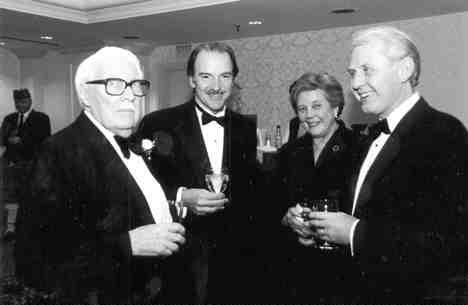
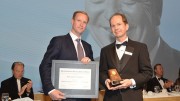
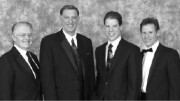
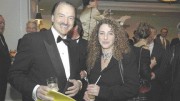
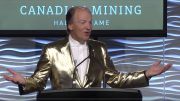
Be the first to comment on "Canadian Mining Hall of Fame salutes six"